Analysis of the Primary Healthcare System in New Zealand
VerifiedAdded on 2022/11/22
|17
|4613
|328
Report
AI Summary
This report provides a comprehensive overview of New Zealand's primary healthcare system, examining its strategy, key directions, and the involvement of various stakeholders. It delves into the New Zealand Cancer Plan, outlining its principles, actions, and future goals, emphasizing the importance of early detection and prevention. The report further explores modifiable risk factors, particularly focusing on the impact of smoking on lung cancer, detailing the mechanisms of harm and the effectiveness of cessation efforts. It highlights the role of nurses in primary healthcare settings in promoting health equity and supporting smoking cessation initiatives, aligned with the Smoke-free 2025 campaign. The report underscores the importance of addressing health inequalities and the need for continuous improvement in healthcare quality and information systems.
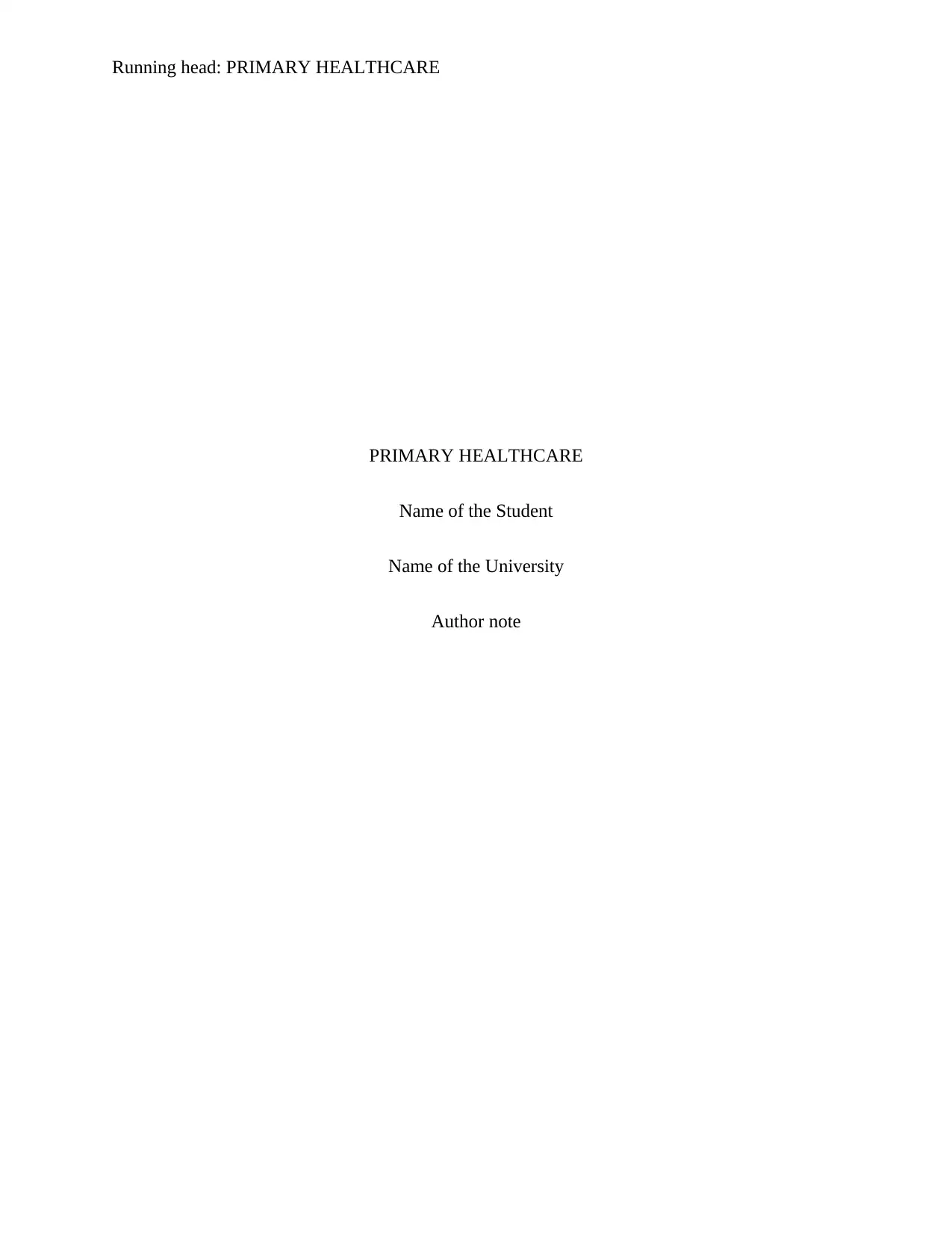
Running head: PRIMARY HEALTHCARE
PRIMARY HEALTHCARE
Name of the Student
Name of the University
Author note
PRIMARY HEALTHCARE
Name of the Student
Name of the University
Author note
Paraphrase This Document
Need a fresh take? Get an instant paraphrase of this document with our AI Paraphraser
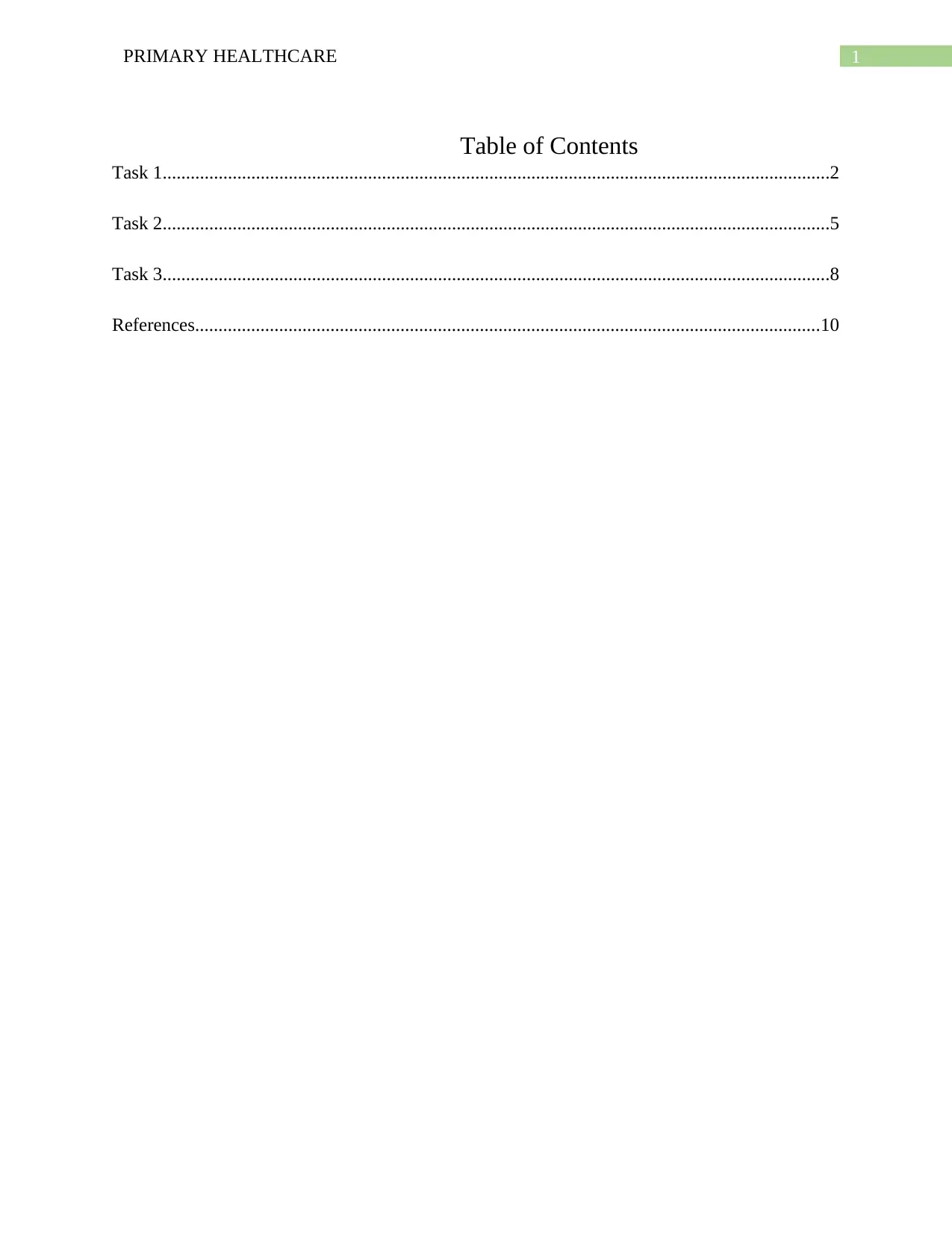
1PRIMARY HEALTHCARE
Table of Contents
Task 1...............................................................................................................................................2
Task 2...............................................................................................................................................5
Task 3...............................................................................................................................................8
References......................................................................................................................................10
Table of Contents
Task 1...............................................................................................................................................2
Task 2...............................................................................................................................................5
Task 3...............................................................................................................................................8
References......................................................................................................................................10
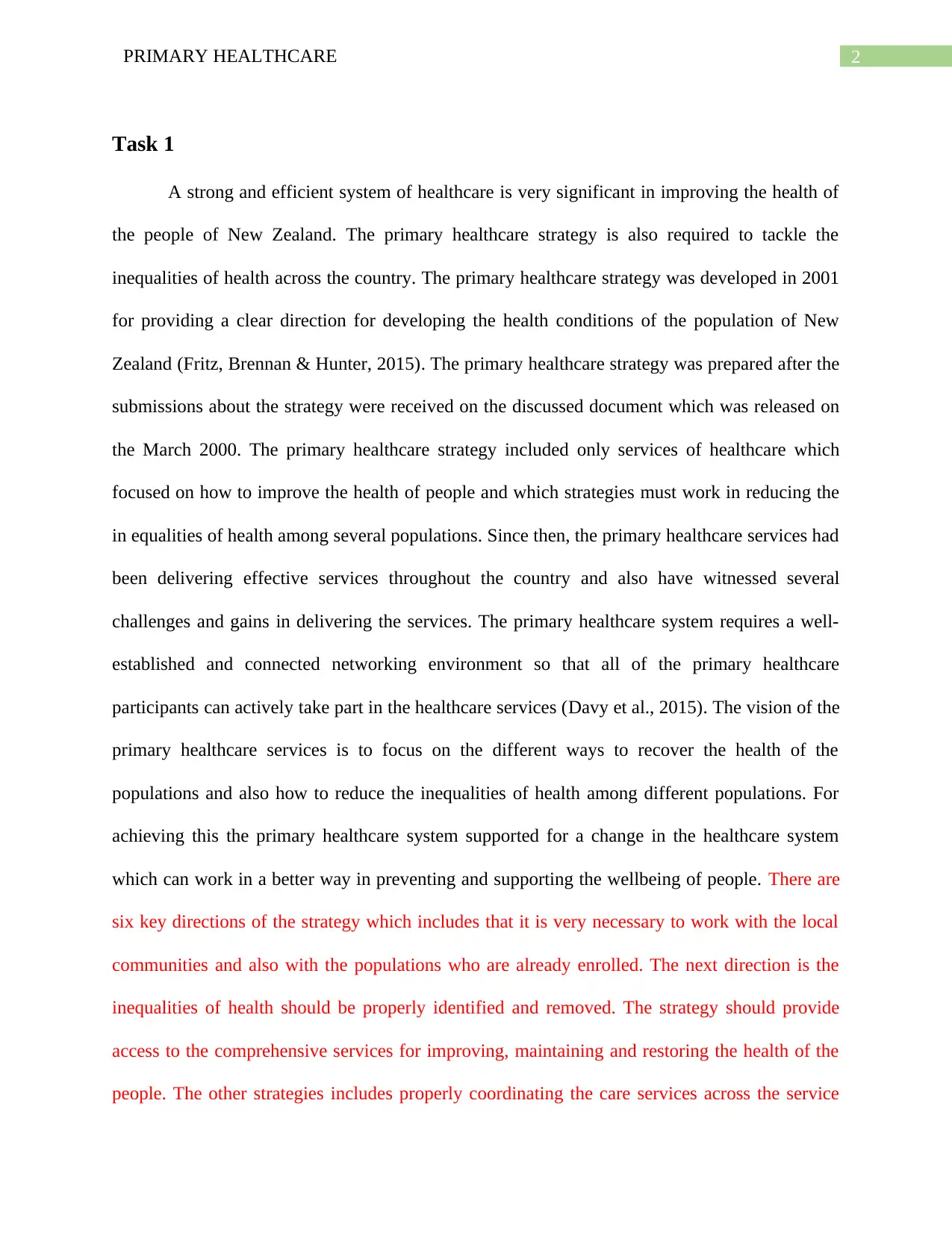
2PRIMARY HEALTHCARE
Task 1
A strong and efficient system of healthcare is very significant in improving the health of
the people of New Zealand. The primary healthcare strategy is also required to tackle the
inequalities of health across the country. The primary healthcare strategy was developed in 2001
for providing a clear direction for developing the health conditions of the population of New
Zealand (Fritz, Brennan & Hunter, 2015). The primary healthcare strategy was prepared after the
submissions about the strategy were received on the discussed document which was released on
the March 2000. The primary healthcare strategy included only services of healthcare which
focused on how to improve the health of people and which strategies must work in reducing the
in equalities of health among several populations. Since then, the primary healthcare services had
been delivering effective services throughout the country and also have witnessed several
challenges and gains in delivering the services. The primary healthcare system requires a well-
established and connected networking environment so that all of the primary healthcare
participants can actively take part in the healthcare services (Davy et al., 2015). The vision of the
primary healthcare services is to focus on the different ways to recover the health of the
populations and also how to reduce the inequalities of health among different populations. For
achieving this the primary healthcare system supported for a change in the healthcare system
which can work in a better way in preventing and supporting the wellbeing of people. There are
six key directions of the strategy which includes that it is very necessary to work with the local
communities and also with the populations who are already enrolled. The next direction is the
inequalities of health should be properly identified and removed. The strategy should provide
access to the comprehensive services for improving, maintaining and restoring the health of the
people. The other strategies includes properly coordinating the care services across the service
Task 1
A strong and efficient system of healthcare is very significant in improving the health of
the people of New Zealand. The primary healthcare strategy is also required to tackle the
inequalities of health across the country. The primary healthcare strategy was developed in 2001
for providing a clear direction for developing the health conditions of the population of New
Zealand (Fritz, Brennan & Hunter, 2015). The primary healthcare strategy was prepared after the
submissions about the strategy were received on the discussed document which was released on
the March 2000. The primary healthcare strategy included only services of healthcare which
focused on how to improve the health of people and which strategies must work in reducing the
in equalities of health among several populations. Since then, the primary healthcare services had
been delivering effective services throughout the country and also have witnessed several
challenges and gains in delivering the services. The primary healthcare system requires a well-
established and connected networking environment so that all of the primary healthcare
participants can actively take part in the healthcare services (Davy et al., 2015). The vision of the
primary healthcare services is to focus on the different ways to recover the health of the
populations and also how to reduce the inequalities of health among different populations. For
achieving this the primary healthcare system supported for a change in the healthcare system
which can work in a better way in preventing and supporting the wellbeing of people. There are
six key directions of the strategy which includes that it is very necessary to work with the local
communities and also with the populations who are already enrolled. The next direction is the
inequalities of health should be properly identified and removed. The strategy should provide
access to the comprehensive services for improving, maintaining and restoring the health of the
people. The other strategies includes properly coordinating the care services across the service
⊘ This is a preview!⊘
Do you want full access?
Subscribe today to unlock all pages.

Trusted by 1+ million students worldwide
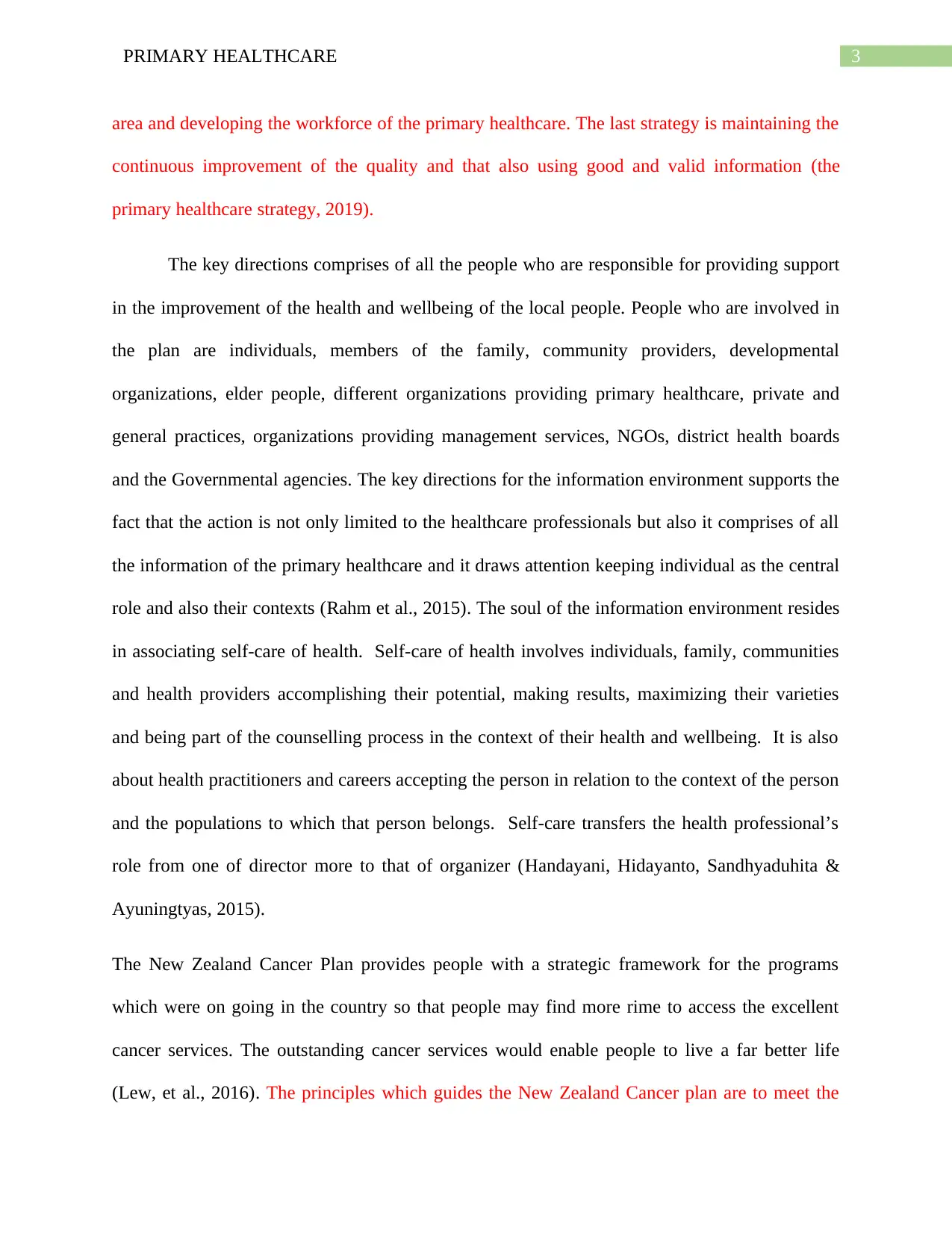
3PRIMARY HEALTHCARE
area and developing the workforce of the primary healthcare. The last strategy is maintaining the
continuous improvement of the quality and that also using good and valid information (the
primary healthcare strategy, 2019).
The key directions comprises of all the people who are responsible for providing support
in the improvement of the health and wellbeing of the local people. People who are involved in
the plan are individuals, members of the family, community providers, developmental
organizations, elder people, different organizations providing primary healthcare, private and
general practices, organizations providing management services, NGOs, district health boards
and the Governmental agencies. The key directions for the information environment supports the
fact that the action is not only limited to the healthcare professionals but also it comprises of all
the information of the primary healthcare and it draws attention keeping individual as the central
role and also their contexts (Rahm et al., 2015). The soul of the information environment resides
in associating self-care of health. Self-care of health involves individuals, family, communities
and health providers accomplishing their potential, making results, maximizing their varieties
and being part of the counselling process in the context of their health and wellbeing. It is also
about health practitioners and careers accepting the person in relation to the context of the person
and the populations to which that person belongs. Self-care transfers the health professional’s
role from one of director more to that of organizer (Handayani, Hidayanto, Sandhyaduhita &
Ayuningtyas, 2015).
The New Zealand Cancer Plan provides people with a strategic framework for the programs
which were on going in the country so that people may find more rime to access the excellent
cancer services. The outstanding cancer services would enable people to live a far better life
(Lew, et al., 2016). The principles which guides the New Zealand Cancer plan are to meet the
area and developing the workforce of the primary healthcare. The last strategy is maintaining the
continuous improvement of the quality and that also using good and valid information (the
primary healthcare strategy, 2019).
The key directions comprises of all the people who are responsible for providing support
in the improvement of the health and wellbeing of the local people. People who are involved in
the plan are individuals, members of the family, community providers, developmental
organizations, elder people, different organizations providing primary healthcare, private and
general practices, organizations providing management services, NGOs, district health boards
and the Governmental agencies. The key directions for the information environment supports the
fact that the action is not only limited to the healthcare professionals but also it comprises of all
the information of the primary healthcare and it draws attention keeping individual as the central
role and also their contexts (Rahm et al., 2015). The soul of the information environment resides
in associating self-care of health. Self-care of health involves individuals, family, communities
and health providers accomplishing their potential, making results, maximizing their varieties
and being part of the counselling process in the context of their health and wellbeing. It is also
about health practitioners and careers accepting the person in relation to the context of the person
and the populations to which that person belongs. Self-care transfers the health professional’s
role from one of director more to that of organizer (Handayani, Hidayanto, Sandhyaduhita &
Ayuningtyas, 2015).
The New Zealand Cancer Plan provides people with a strategic framework for the programs
which were on going in the country so that people may find more rime to access the excellent
cancer services. The outstanding cancer services would enable people to live a far better life
(Lew, et al., 2016). The principles which guides the New Zealand Cancer plan are to meet the
Paraphrase This Document
Need a fresh take? Get an instant paraphrase of this document with our AI Paraphraser
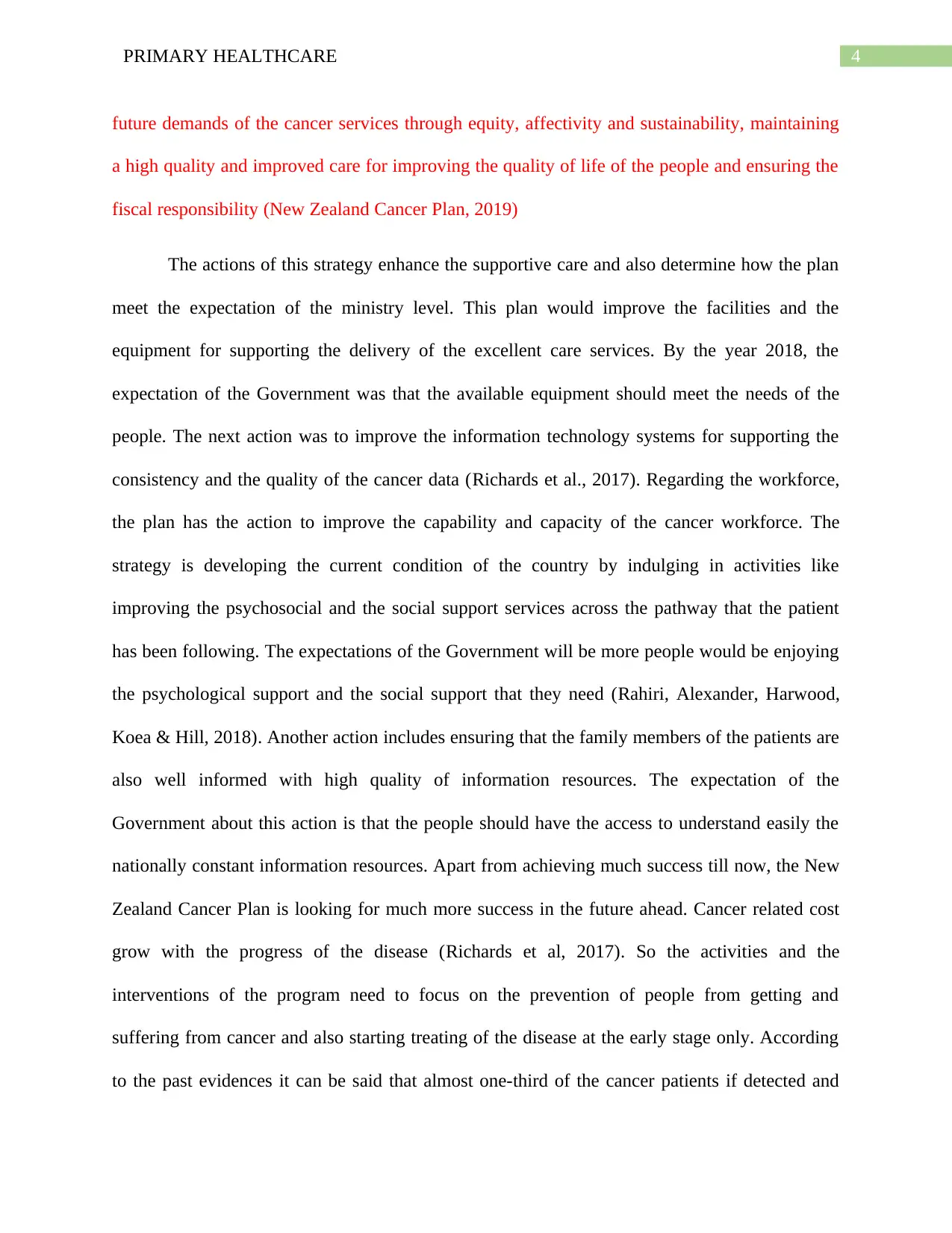
4PRIMARY HEALTHCARE
future demands of the cancer services through equity, affectivity and sustainability, maintaining
a high quality and improved care for improving the quality of life of the people and ensuring the
fiscal responsibility (New Zealand Cancer Plan, 2019)
The actions of this strategy enhance the supportive care and also determine how the plan
meet the expectation of the ministry level. This plan would improve the facilities and the
equipment for supporting the delivery of the excellent care services. By the year 2018, the
expectation of the Government was that the available equipment should meet the needs of the
people. The next action was to improve the information technology systems for supporting the
consistency and the quality of the cancer data (Richards et al., 2017). Regarding the workforce,
the plan has the action to improve the capability and capacity of the cancer workforce. The
strategy is developing the current condition of the country by indulging in activities like
improving the psychosocial and the social support services across the pathway that the patient
has been following. The expectations of the Government will be more people would be enjoying
the psychological support and the social support that they need (Rahiri, Alexander, Harwood,
Koea & Hill, 2018). Another action includes ensuring that the family members of the patients are
also well informed with high quality of information resources. The expectation of the
Government about this action is that the people should have the access to understand easily the
nationally constant information resources. Apart from achieving much success till now, the New
Zealand Cancer Plan is looking for much more success in the future ahead. Cancer related cost
grow with the progress of the disease (Richards et al, 2017). So the activities and the
interventions of the program need to focus on the prevention of people from getting and
suffering from cancer and also starting treating of the disease at the early stage only. According
to the past evidences it can be said that almost one-third of the cancer patients if detected and
future demands of the cancer services through equity, affectivity and sustainability, maintaining
a high quality and improved care for improving the quality of life of the people and ensuring the
fiscal responsibility (New Zealand Cancer Plan, 2019)
The actions of this strategy enhance the supportive care and also determine how the plan
meet the expectation of the ministry level. This plan would improve the facilities and the
equipment for supporting the delivery of the excellent care services. By the year 2018, the
expectation of the Government was that the available equipment should meet the needs of the
people. The next action was to improve the information technology systems for supporting the
consistency and the quality of the cancer data (Richards et al., 2017). Regarding the workforce,
the plan has the action to improve the capability and capacity of the cancer workforce. The
strategy is developing the current condition of the country by indulging in activities like
improving the psychosocial and the social support services across the pathway that the patient
has been following. The expectations of the Government will be more people would be enjoying
the psychological support and the social support that they need (Rahiri, Alexander, Harwood,
Koea & Hill, 2018). Another action includes ensuring that the family members of the patients are
also well informed with high quality of information resources. The expectation of the
Government about this action is that the people should have the access to understand easily the
nationally constant information resources. Apart from achieving much success till now, the New
Zealand Cancer Plan is looking for much more success in the future ahead. Cancer related cost
grow with the progress of the disease (Richards et al, 2017). So the activities and the
interventions of the program need to focus on the prevention of people from getting and
suffering from cancer and also starting treating of the disease at the early stage only. According
to the past evidences it can be said that almost one-third of the cancer patients if detected and
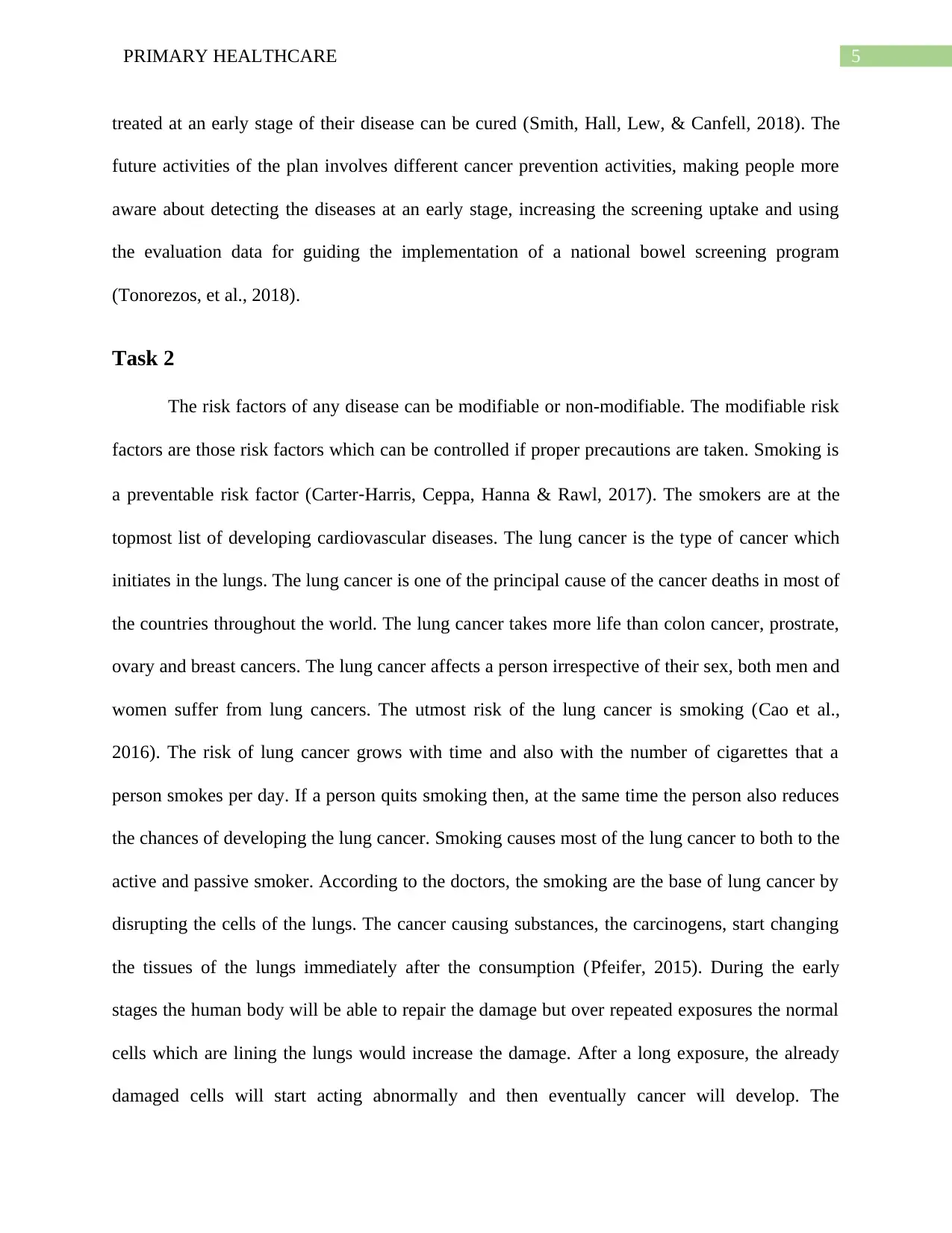
5PRIMARY HEALTHCARE
treated at an early stage of their disease can be cured (Smith, Hall, Lew, & Canfell, 2018). The
future activities of the plan involves different cancer prevention activities, making people more
aware about detecting the diseases at an early stage, increasing the screening uptake and using
the evaluation data for guiding the implementation of a national bowel screening program
(Tonorezos, et al., 2018).
Task 2
The risk factors of any disease can be modifiable or non-modifiable. The modifiable risk
factors are those risk factors which can be controlled if proper precautions are taken. Smoking is
a preventable risk factor (Carter‐Harris, Ceppa, Hanna & Rawl, 2017). The smokers are at the
topmost list of developing cardiovascular diseases. The lung cancer is the type of cancer which
initiates in the lungs. The lung cancer is one of the principal cause of the cancer deaths in most of
the countries throughout the world. The lung cancer takes more life than colon cancer, prostrate,
ovary and breast cancers. The lung cancer affects a person irrespective of their sex, both men and
women suffer from lung cancers. The utmost risk of the lung cancer is smoking (Cao et al.,
2016). The risk of lung cancer grows with time and also with the number of cigarettes that a
person smokes per day. If a person quits smoking then, at the same time the person also reduces
the chances of developing the lung cancer. Smoking causes most of the lung cancer to both to the
active and passive smoker. According to the doctors, the smoking are the base of lung cancer by
disrupting the cells of the lungs. The cancer causing substances, the carcinogens, start changing
the tissues of the lungs immediately after the consumption (Pfeifer, 2015). During the early
stages the human body will be able to repair the damage but over repeated exposures the normal
cells which are lining the lungs would increase the damage. After a long exposure, the already
damaged cells will start acting abnormally and then eventually cancer will develop. The
treated at an early stage of their disease can be cured (Smith, Hall, Lew, & Canfell, 2018). The
future activities of the plan involves different cancer prevention activities, making people more
aware about detecting the diseases at an early stage, increasing the screening uptake and using
the evaluation data for guiding the implementation of a national bowel screening program
(Tonorezos, et al., 2018).
Task 2
The risk factors of any disease can be modifiable or non-modifiable. The modifiable risk
factors are those risk factors which can be controlled if proper precautions are taken. Smoking is
a preventable risk factor (Carter‐Harris, Ceppa, Hanna & Rawl, 2017). The smokers are at the
topmost list of developing cardiovascular diseases. The lung cancer is the type of cancer which
initiates in the lungs. The lung cancer is one of the principal cause of the cancer deaths in most of
the countries throughout the world. The lung cancer takes more life than colon cancer, prostrate,
ovary and breast cancers. The lung cancer affects a person irrespective of their sex, both men and
women suffer from lung cancers. The utmost risk of the lung cancer is smoking (Cao et al.,
2016). The risk of lung cancer grows with time and also with the number of cigarettes that a
person smokes per day. If a person quits smoking then, at the same time the person also reduces
the chances of developing the lung cancer. Smoking causes most of the lung cancer to both to the
active and passive smoker. According to the doctors, the smoking are the base of lung cancer by
disrupting the cells of the lungs. The cancer causing substances, the carcinogens, start changing
the tissues of the lungs immediately after the consumption (Pfeifer, 2015). During the early
stages the human body will be able to repair the damage but over repeated exposures the normal
cells which are lining the lungs would increase the damage. After a long exposure, the already
damaged cells will start acting abnormally and then eventually cancer will develop. The
⊘ This is a preview!⊘
Do you want full access?
Subscribe today to unlock all pages.

Trusted by 1+ million students worldwide
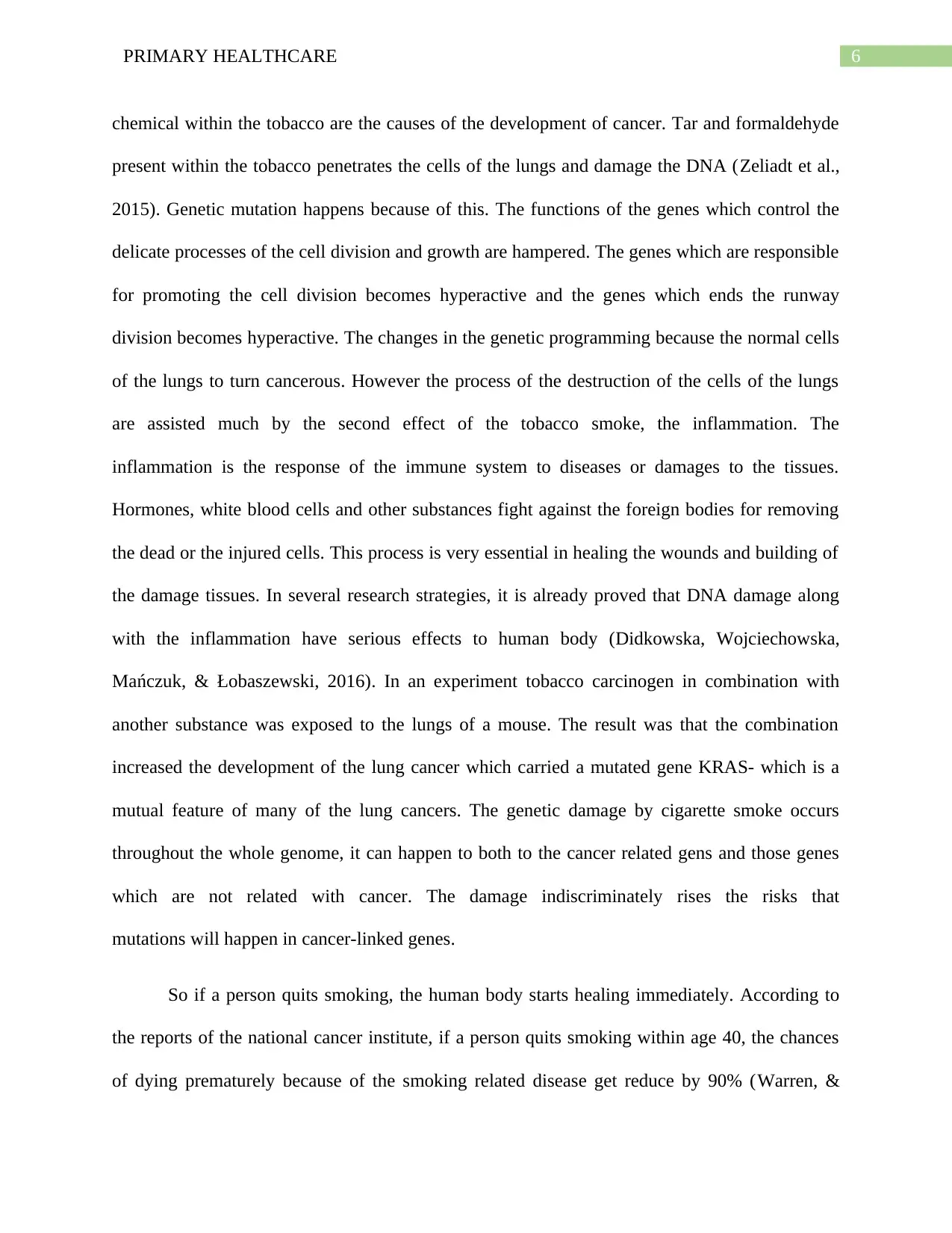
6PRIMARY HEALTHCARE
chemical within the tobacco are the causes of the development of cancer. Tar and formaldehyde
present within the tobacco penetrates the cells of the lungs and damage the DNA (Zeliadt et al.,
2015). Genetic mutation happens because of this. The functions of the genes which control the
delicate processes of the cell division and growth are hampered. The genes which are responsible
for promoting the cell division becomes hyperactive and the genes which ends the runway
division becomes hyperactive. The changes in the genetic programming because the normal cells
of the lungs to turn cancerous. However the process of the destruction of the cells of the lungs
are assisted much by the second effect of the tobacco smoke, the inflammation. The
inflammation is the response of the immune system to diseases or damages to the tissues.
Hormones, white blood cells and other substances fight against the foreign bodies for removing
the dead or the injured cells. This process is very essential in healing the wounds and building of
the damage tissues. In several research strategies, it is already proved that DNA damage along
with the inflammation have serious effects to human body (Didkowska, Wojciechowska,
Mańczuk, & Łobaszewski, 2016). In an experiment tobacco carcinogen in combination with
another substance was exposed to the lungs of a mouse. The result was that the combination
increased the development of the lung cancer which carried a mutated gene KRAS- which is a
mutual feature of many of the lung cancers. The genetic damage by cigarette smoke occurs
throughout the whole genome, it can happen to both to the cancer related gens and those genes
which are not related with cancer. The damage indiscriminately rises the risks that
mutations will happen in cancer-linked genes.
So if a person quits smoking, the human body starts healing immediately. According to
the reports of the national cancer institute, if a person quits smoking within age 40, the chances
of dying prematurely because of the smoking related disease get reduce by 90% (Warren, &
chemical within the tobacco are the causes of the development of cancer. Tar and formaldehyde
present within the tobacco penetrates the cells of the lungs and damage the DNA (Zeliadt et al.,
2015). Genetic mutation happens because of this. The functions of the genes which control the
delicate processes of the cell division and growth are hampered. The genes which are responsible
for promoting the cell division becomes hyperactive and the genes which ends the runway
division becomes hyperactive. The changes in the genetic programming because the normal cells
of the lungs to turn cancerous. However the process of the destruction of the cells of the lungs
are assisted much by the second effect of the tobacco smoke, the inflammation. The
inflammation is the response of the immune system to diseases or damages to the tissues.
Hormones, white blood cells and other substances fight against the foreign bodies for removing
the dead or the injured cells. This process is very essential in healing the wounds and building of
the damage tissues. In several research strategies, it is already proved that DNA damage along
with the inflammation have serious effects to human body (Didkowska, Wojciechowska,
Mańczuk, & Łobaszewski, 2016). In an experiment tobacco carcinogen in combination with
another substance was exposed to the lungs of a mouse. The result was that the combination
increased the development of the lung cancer which carried a mutated gene KRAS- which is a
mutual feature of many of the lung cancers. The genetic damage by cigarette smoke occurs
throughout the whole genome, it can happen to both to the cancer related gens and those genes
which are not related with cancer. The damage indiscriminately rises the risks that
mutations will happen in cancer-linked genes.
So if a person quits smoking, the human body starts healing immediately. According to
the reports of the national cancer institute, if a person quits smoking within age 40, the chances
of dying prematurely because of the smoking related disease get reduce by 90% (Warren, &
Paraphrase This Document
Need a fresh take? Get an instant paraphrase of this document with our AI Paraphraser
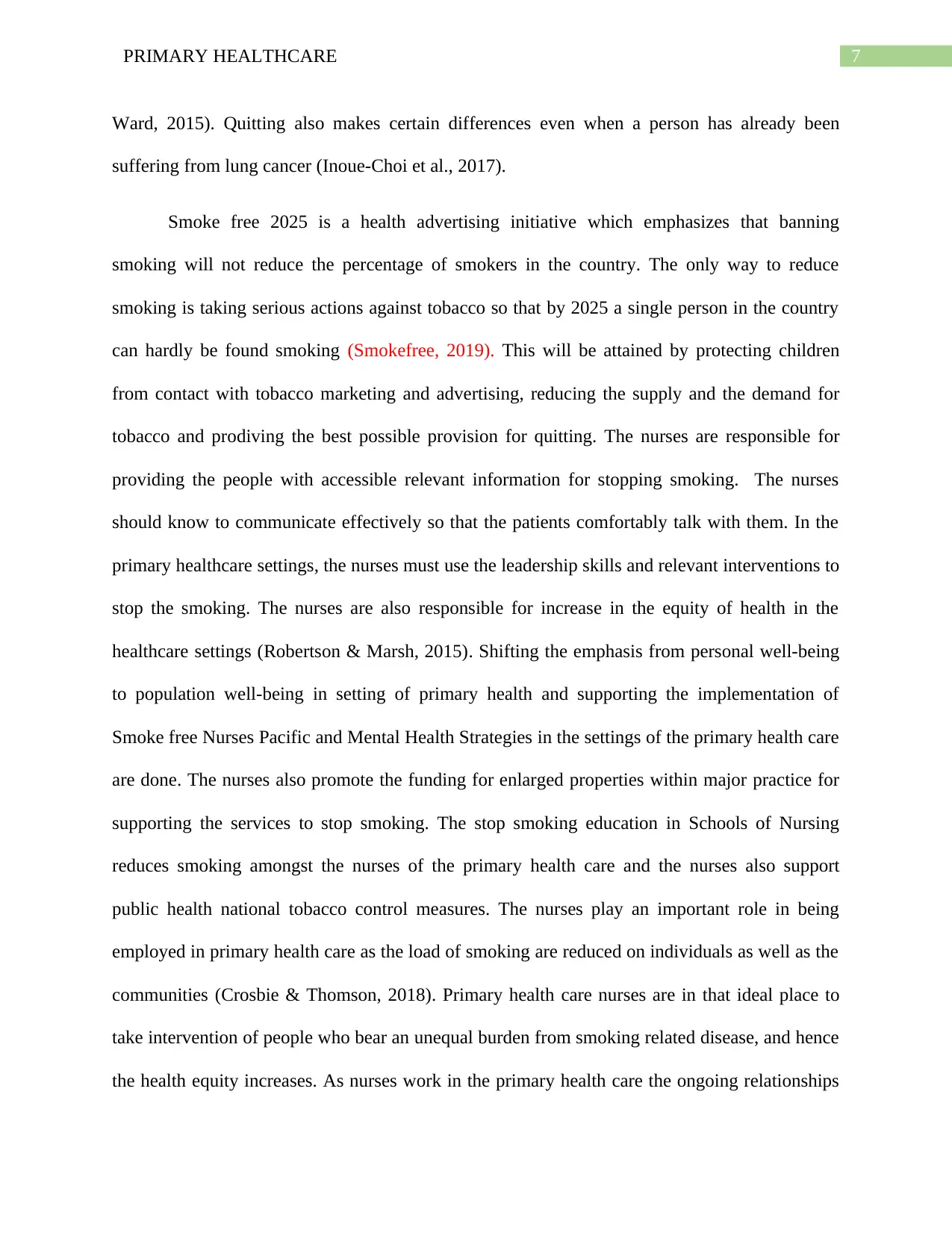
7PRIMARY HEALTHCARE
Ward, 2015). Quitting also makes certain differences even when a person has already been
suffering from lung cancer (Inoue-Choi et al., 2017).
Smoke free 2025 is a health advertising initiative which emphasizes that banning
smoking will not reduce the percentage of smokers in the country. The only way to reduce
smoking is taking serious actions against tobacco so that by 2025 a single person in the country
can hardly be found smoking (Smokefree, 2019). This will be attained by protecting children
from contact with tobacco marketing and advertising, reducing the supply and the demand for
tobacco and prodiving the best possible provision for quitting. The nurses are responsible for
providing the people with accessible relevant information for stopping smoking. The nurses
should know to communicate effectively so that the patients comfortably talk with them. In the
primary healthcare settings, the nurses must use the leadership skills and relevant interventions to
stop the smoking. The nurses are also responsible for increase in the equity of health in the
healthcare settings (Robertson & Marsh, 2015). Shifting the emphasis from personal well-being
to population well-being in setting of primary health and supporting the implementation of
Smoke free Nurses Pacific and Mental Health Strategies in the settings of the primary health care
are done. The nurses also promote the funding for enlarged properties within major practice for
supporting the services to stop smoking. The stop smoking education in Schools of Nursing
reduces smoking amongst the nurses of the primary health care and the nurses also support
public health national tobacco control measures. The nurses play an important role in being
employed in primary health care as the load of smoking are reduced on individuals as well as the
communities (Crosbie & Thomson, 2018). Primary health care nurses are in that ideal place to
take intervention of people who bear an unequal burden from smoking related disease, and hence
the health equity increases. As nurses work in the primary health care the ongoing relationships
Ward, 2015). Quitting also makes certain differences even when a person has already been
suffering from lung cancer (Inoue-Choi et al., 2017).
Smoke free 2025 is a health advertising initiative which emphasizes that banning
smoking will not reduce the percentage of smokers in the country. The only way to reduce
smoking is taking serious actions against tobacco so that by 2025 a single person in the country
can hardly be found smoking (Smokefree, 2019). This will be attained by protecting children
from contact with tobacco marketing and advertising, reducing the supply and the demand for
tobacco and prodiving the best possible provision for quitting. The nurses are responsible for
providing the people with accessible relevant information for stopping smoking. The nurses
should know to communicate effectively so that the patients comfortably talk with them. In the
primary healthcare settings, the nurses must use the leadership skills and relevant interventions to
stop the smoking. The nurses are also responsible for increase in the equity of health in the
healthcare settings (Robertson & Marsh, 2015). Shifting the emphasis from personal well-being
to population well-being in setting of primary health and supporting the implementation of
Smoke free Nurses Pacific and Mental Health Strategies in the settings of the primary health care
are done. The nurses also promote the funding for enlarged properties within major practice for
supporting the services to stop smoking. The stop smoking education in Schools of Nursing
reduces smoking amongst the nurses of the primary health care and the nurses also support
public health national tobacco control measures. The nurses play an important role in being
employed in primary health care as the load of smoking are reduced on individuals as well as the
communities (Crosbie & Thomson, 2018). Primary health care nurses are in that ideal place to
take intervention of people who bear an unequal burden from smoking related disease, and hence
the health equity increases. As nurses work in the primary health care the ongoing relationships
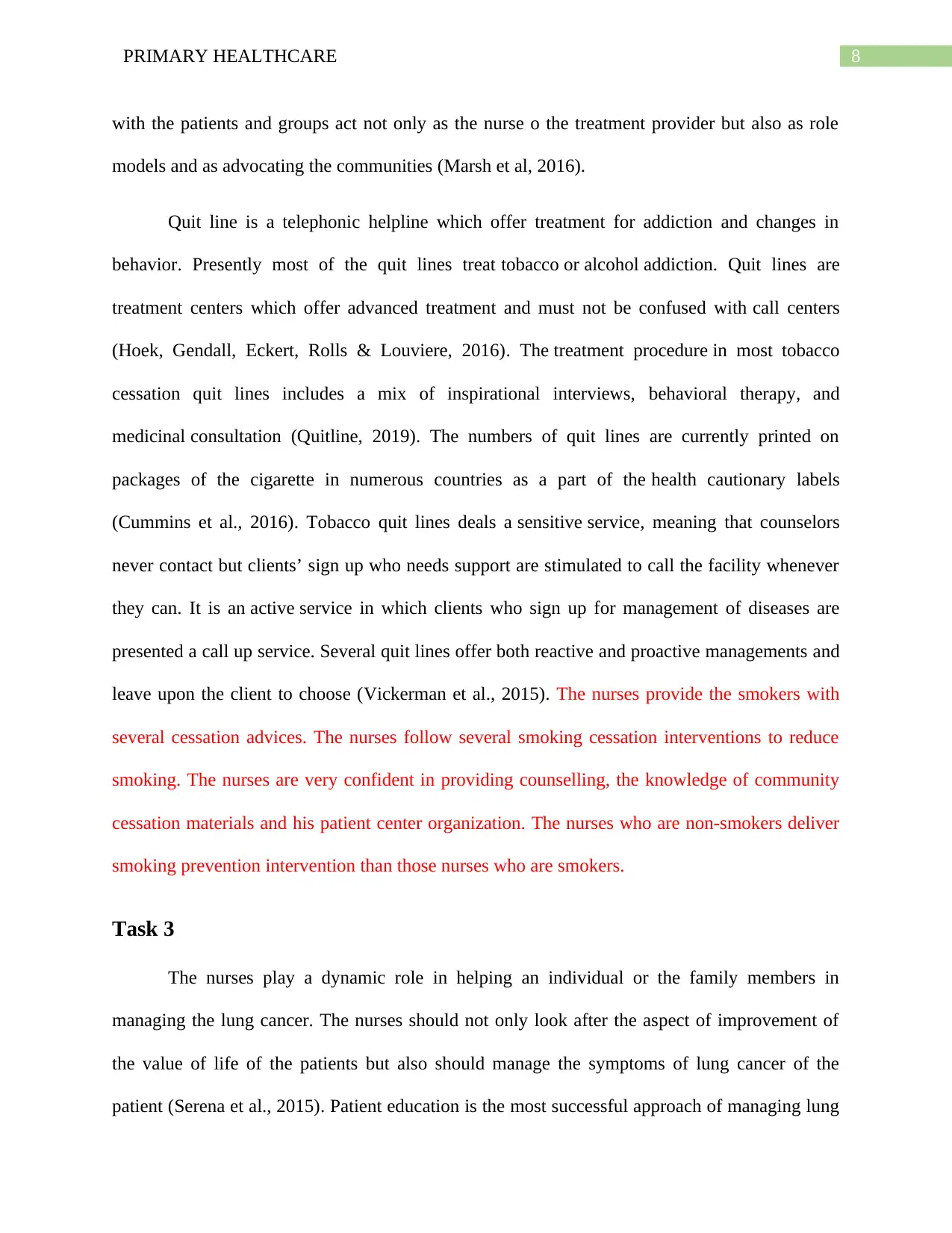
8PRIMARY HEALTHCARE
with the patients and groups act not only as the nurse o the treatment provider but also as role
models and as advocating the communities (Marsh et al, 2016).
Quit line is a telephonic helpline which offer treatment for addiction and changes in
behavior. Presently most of the quit lines treat tobacco or alcohol addiction. Quit lines are
treatment centers which offer advanced treatment and must not be confused with call centers
(Hoek, Gendall, Eckert, Rolls & Louviere, 2016). The treatment procedure in most tobacco
cessation quit lines includes a mix of inspirational interviews, behavioral therapy, and
medicinal consultation (Quitline, 2019). The numbers of quit lines are currently printed on
packages of the cigarette in numerous countries as a part of the health cautionary labels
(Cummins et al., 2016). Tobacco quit lines deals a sensitive service, meaning that counselors
never contact but clients’ sign up who needs support are stimulated to call the facility whenever
they can. It is an active service in which clients who sign up for management of diseases are
presented a call up service. Several quit lines offer both reactive and proactive managements and
leave upon the client to choose (Vickerman et al., 2015). The nurses provide the smokers with
several cessation advices. The nurses follow several smoking cessation interventions to reduce
smoking. The nurses are very confident in providing counselling, the knowledge of community
cessation materials and his patient center organization. The nurses who are non-smokers deliver
smoking prevention intervention than those nurses who are smokers.
Task 3
The nurses play a dynamic role in helping an individual or the family members in
managing the lung cancer. The nurses should not only look after the aspect of improvement of
the value of life of the patients but also should manage the symptoms of lung cancer of the
patient (Serena et al., 2015). Patient education is the most successful approach of managing lung
with the patients and groups act not only as the nurse o the treatment provider but also as role
models and as advocating the communities (Marsh et al, 2016).
Quit line is a telephonic helpline which offer treatment for addiction and changes in
behavior. Presently most of the quit lines treat tobacco or alcohol addiction. Quit lines are
treatment centers which offer advanced treatment and must not be confused with call centers
(Hoek, Gendall, Eckert, Rolls & Louviere, 2016). The treatment procedure in most tobacco
cessation quit lines includes a mix of inspirational interviews, behavioral therapy, and
medicinal consultation (Quitline, 2019). The numbers of quit lines are currently printed on
packages of the cigarette in numerous countries as a part of the health cautionary labels
(Cummins et al., 2016). Tobacco quit lines deals a sensitive service, meaning that counselors
never contact but clients’ sign up who needs support are stimulated to call the facility whenever
they can. It is an active service in which clients who sign up for management of diseases are
presented a call up service. Several quit lines offer both reactive and proactive managements and
leave upon the client to choose (Vickerman et al., 2015). The nurses provide the smokers with
several cessation advices. The nurses follow several smoking cessation interventions to reduce
smoking. The nurses are very confident in providing counselling, the knowledge of community
cessation materials and his patient center organization. The nurses who are non-smokers deliver
smoking prevention intervention than those nurses who are smokers.
Task 3
The nurses play a dynamic role in helping an individual or the family members in
managing the lung cancer. The nurses should not only look after the aspect of improvement of
the value of life of the patients but also should manage the symptoms of lung cancer of the
patient (Serena et al., 2015). Patient education is the most successful approach of managing lung
⊘ This is a preview!⊘
Do you want full access?
Subscribe today to unlock all pages.

Trusted by 1+ million students worldwide
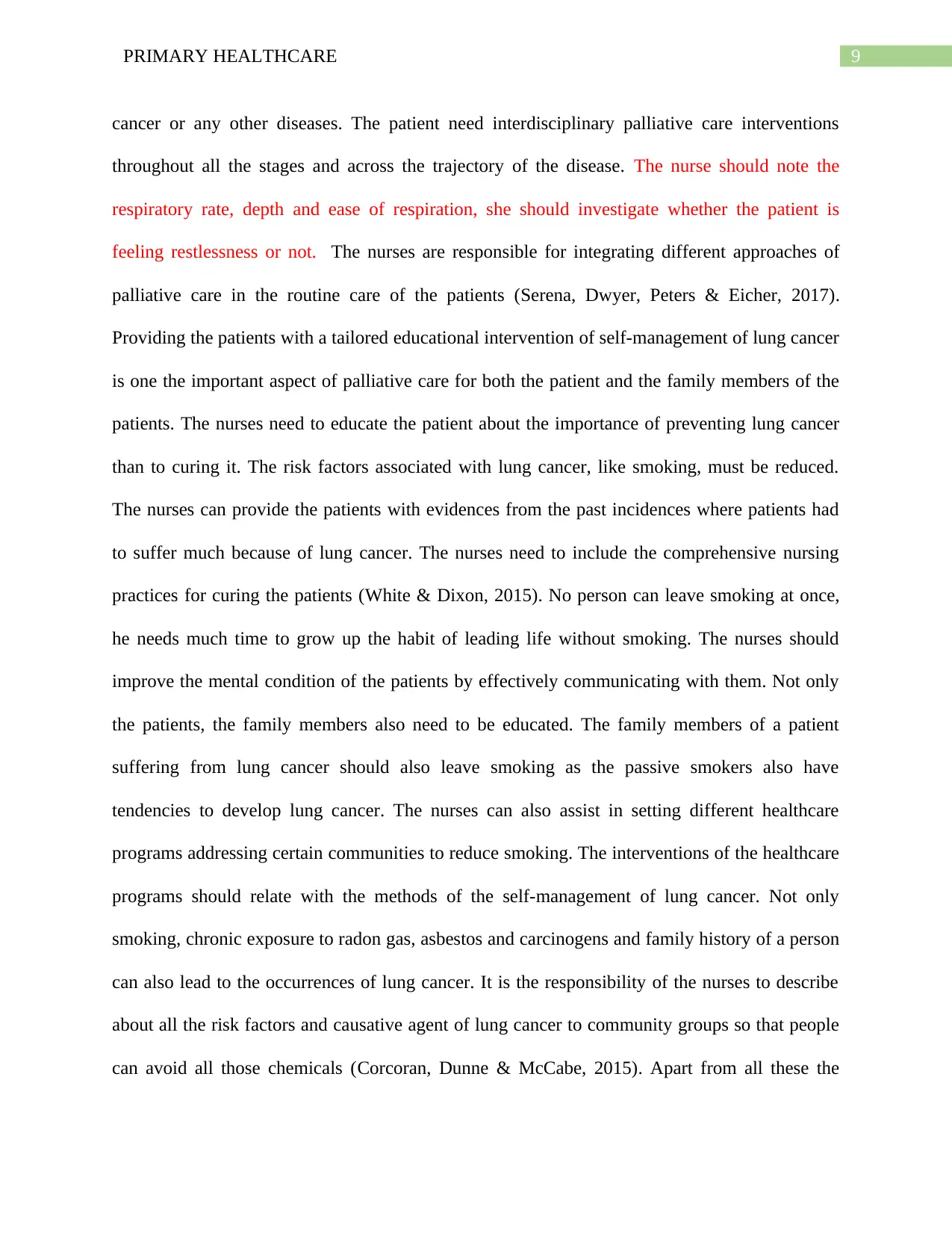
9PRIMARY HEALTHCARE
cancer or any other diseases. The patient need interdisciplinary palliative care interventions
throughout all the stages and across the trajectory of the disease. The nurse should note the
respiratory rate, depth and ease of respiration, she should investigate whether the patient is
feeling restlessness or not. The nurses are responsible for integrating different approaches of
palliative care in the routine care of the patients (Serena, Dwyer, Peters & Eicher, 2017).
Providing the patients with a tailored educational intervention of self-management of lung cancer
is one the important aspect of palliative care for both the patient and the family members of the
patients. The nurses need to educate the patient about the importance of preventing lung cancer
than to curing it. The risk factors associated with lung cancer, like smoking, must be reduced.
The nurses can provide the patients with evidences from the past incidences where patients had
to suffer much because of lung cancer. The nurses need to include the comprehensive nursing
practices for curing the patients (White & Dixon, 2015). No person can leave smoking at once,
he needs much time to grow up the habit of leading life without smoking. The nurses should
improve the mental condition of the patients by effectively communicating with them. Not only
the patients, the family members also need to be educated. The family members of a patient
suffering from lung cancer should also leave smoking as the passive smokers also have
tendencies to develop lung cancer. The nurses can also assist in setting different healthcare
programs addressing certain communities to reduce smoking. The interventions of the healthcare
programs should relate with the methods of the self-management of lung cancer. Not only
smoking, chronic exposure to radon gas, asbestos and carcinogens and family history of a person
can also lead to the occurrences of lung cancer. It is the responsibility of the nurses to describe
about all the risk factors and causative agent of lung cancer to community groups so that people
can avoid all those chemicals (Corcoran, Dunne & McCabe, 2015). Apart from all these the
cancer or any other diseases. The patient need interdisciplinary palliative care interventions
throughout all the stages and across the trajectory of the disease. The nurse should note the
respiratory rate, depth and ease of respiration, she should investigate whether the patient is
feeling restlessness or not. The nurses are responsible for integrating different approaches of
palliative care in the routine care of the patients (Serena, Dwyer, Peters & Eicher, 2017).
Providing the patients with a tailored educational intervention of self-management of lung cancer
is one the important aspect of palliative care for both the patient and the family members of the
patients. The nurses need to educate the patient about the importance of preventing lung cancer
than to curing it. The risk factors associated with lung cancer, like smoking, must be reduced.
The nurses can provide the patients with evidences from the past incidences where patients had
to suffer much because of lung cancer. The nurses need to include the comprehensive nursing
practices for curing the patients (White & Dixon, 2015). No person can leave smoking at once,
he needs much time to grow up the habit of leading life without smoking. The nurses should
improve the mental condition of the patients by effectively communicating with them. Not only
the patients, the family members also need to be educated. The family members of a patient
suffering from lung cancer should also leave smoking as the passive smokers also have
tendencies to develop lung cancer. The nurses can also assist in setting different healthcare
programs addressing certain communities to reduce smoking. The interventions of the healthcare
programs should relate with the methods of the self-management of lung cancer. Not only
smoking, chronic exposure to radon gas, asbestos and carcinogens and family history of a person
can also lead to the occurrences of lung cancer. It is the responsibility of the nurses to describe
about all the risk factors and causative agent of lung cancer to community groups so that people
can avoid all those chemicals (Corcoran, Dunne & McCabe, 2015). Apart from all these the
Paraphrase This Document
Need a fresh take? Get an instant paraphrase of this document with our AI Paraphraser
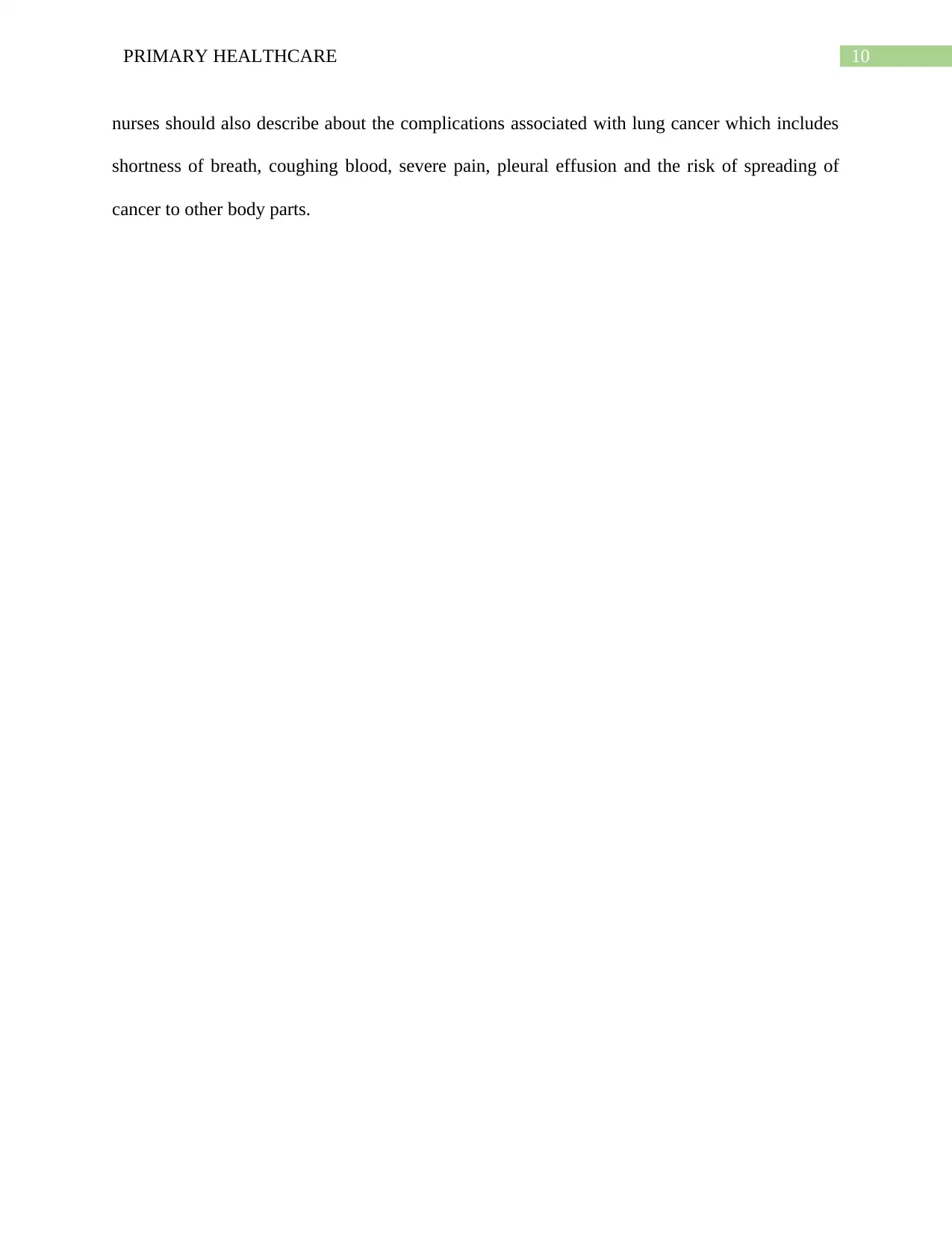
10PRIMARY HEALTHCARE
nurses should also describe about the complications associated with lung cancer which includes
shortness of breath, coughing blood, severe pain, pleural effusion and the risk of spreading of
cancer to other body parts.
nurses should also describe about the complications associated with lung cancer which includes
shortness of breath, coughing blood, severe pain, pleural effusion and the risk of spreading of
cancer to other body parts.
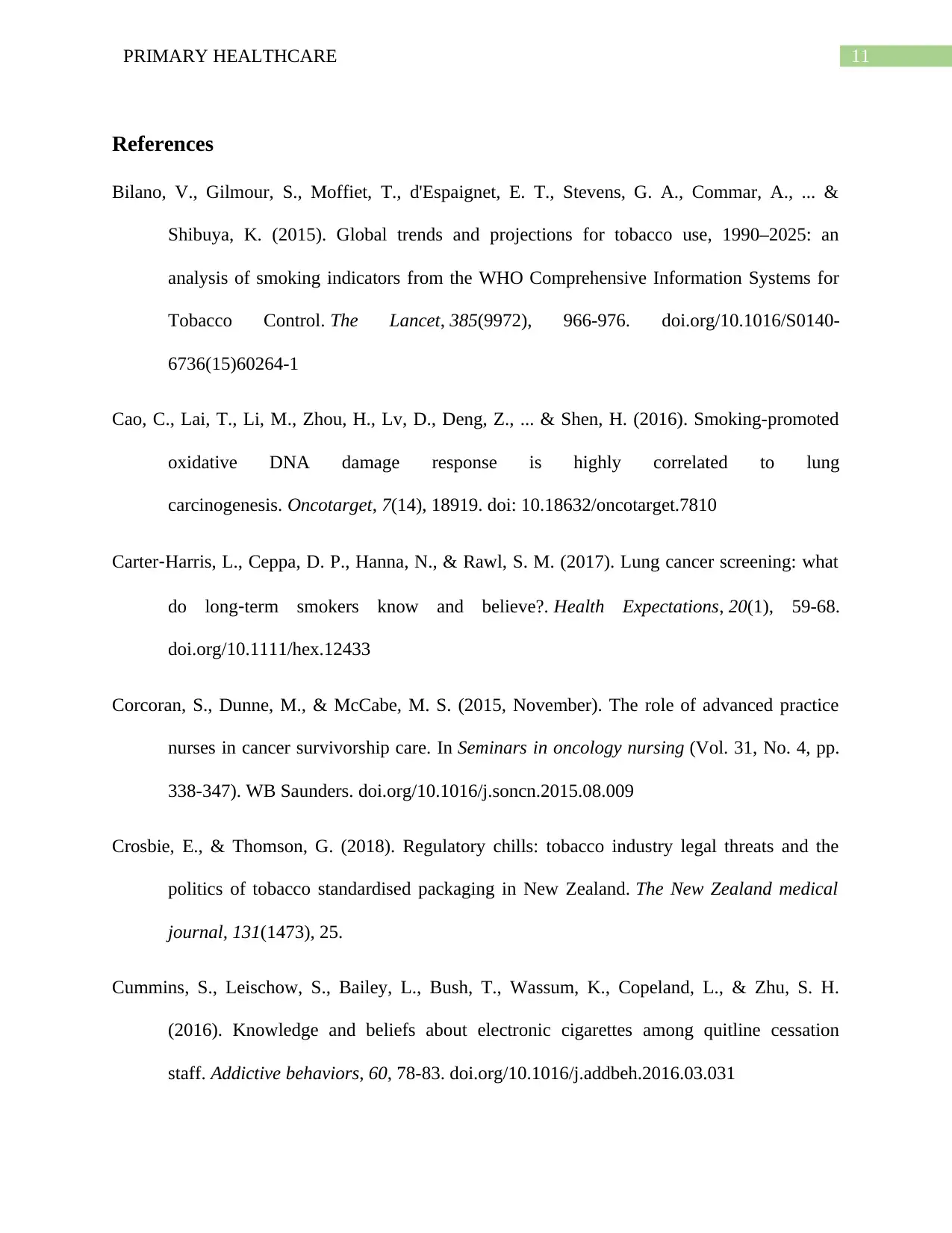
11PRIMARY HEALTHCARE
References
Bilano, V., Gilmour, S., Moffiet, T., d'Espaignet, E. T., Stevens, G. A., Commar, A., ... &
Shibuya, K. (2015). Global trends and projections for tobacco use, 1990–2025: an
analysis of smoking indicators from the WHO Comprehensive Information Systems for
Tobacco Control. The Lancet, 385(9972), 966-976. doi.org/10.1016/S0140-
6736(15)60264-1
Cao, C., Lai, T., Li, M., Zhou, H., Lv, D., Deng, Z., ... & Shen, H. (2016). Smoking-promoted
oxidative DNA damage response is highly correlated to lung
carcinogenesis. Oncotarget, 7(14), 18919. doi: 10.18632/oncotarget.7810
Carter‐Harris, L., Ceppa, D. P., Hanna, N., & Rawl, S. M. (2017). Lung cancer screening: what
do long‐term smokers know and believe?. Health Expectations, 20(1), 59-68.
doi.org/10.1111/hex.12433
Corcoran, S., Dunne, M., & McCabe, M. S. (2015, November). The role of advanced practice
nurses in cancer survivorship care. In Seminars in oncology nursing (Vol. 31, No. 4, pp.
338-347). WB Saunders. doi.org/10.1016/j.soncn.2015.08.009
Crosbie, E., & Thomson, G. (2018). Regulatory chills: tobacco industry legal threats and the
politics of tobacco standardised packaging in New Zealand. The New Zealand medical
journal, 131(1473), 25.
Cummins, S., Leischow, S., Bailey, L., Bush, T., Wassum, K., Copeland, L., & Zhu, S. H.
(2016). Knowledge and beliefs about electronic cigarettes among quitline cessation
staff. Addictive behaviors, 60, 78-83. doi.org/10.1016/j.addbeh.2016.03.031
References
Bilano, V., Gilmour, S., Moffiet, T., d'Espaignet, E. T., Stevens, G. A., Commar, A., ... &
Shibuya, K. (2015). Global trends and projections for tobacco use, 1990–2025: an
analysis of smoking indicators from the WHO Comprehensive Information Systems for
Tobacco Control. The Lancet, 385(9972), 966-976. doi.org/10.1016/S0140-
6736(15)60264-1
Cao, C., Lai, T., Li, M., Zhou, H., Lv, D., Deng, Z., ... & Shen, H. (2016). Smoking-promoted
oxidative DNA damage response is highly correlated to lung
carcinogenesis. Oncotarget, 7(14), 18919. doi: 10.18632/oncotarget.7810
Carter‐Harris, L., Ceppa, D. P., Hanna, N., & Rawl, S. M. (2017). Lung cancer screening: what
do long‐term smokers know and believe?. Health Expectations, 20(1), 59-68.
doi.org/10.1111/hex.12433
Corcoran, S., Dunne, M., & McCabe, M. S. (2015, November). The role of advanced practice
nurses in cancer survivorship care. In Seminars in oncology nursing (Vol. 31, No. 4, pp.
338-347). WB Saunders. doi.org/10.1016/j.soncn.2015.08.009
Crosbie, E., & Thomson, G. (2018). Regulatory chills: tobacco industry legal threats and the
politics of tobacco standardised packaging in New Zealand. The New Zealand medical
journal, 131(1473), 25.
Cummins, S., Leischow, S., Bailey, L., Bush, T., Wassum, K., Copeland, L., & Zhu, S. H.
(2016). Knowledge and beliefs about electronic cigarettes among quitline cessation
staff. Addictive behaviors, 60, 78-83. doi.org/10.1016/j.addbeh.2016.03.031
⊘ This is a preview!⊘
Do you want full access?
Subscribe today to unlock all pages.

Trusted by 1+ million students worldwide
1 out of 17
Related Documents
Your All-in-One AI-Powered Toolkit for Academic Success.
+13062052269
info@desklib.com
Available 24*7 on WhatsApp / Email
![[object Object]](/_next/static/media/star-bottom.7253800d.svg)
Unlock your academic potential
Copyright © 2020–2025 A2Z Services. All Rights Reserved. Developed and managed by ZUCOL.





